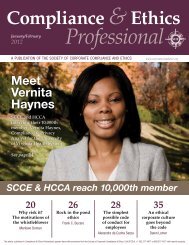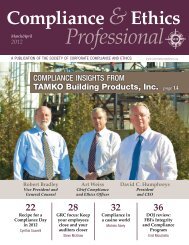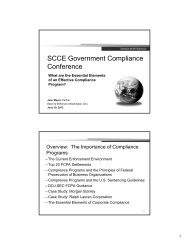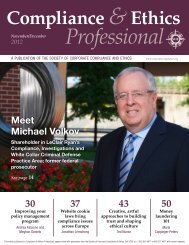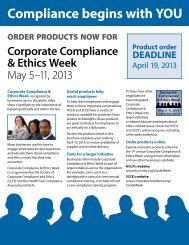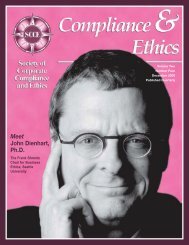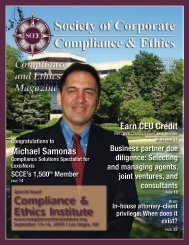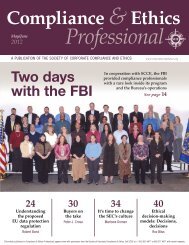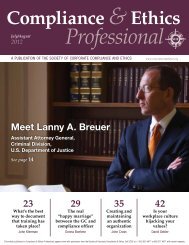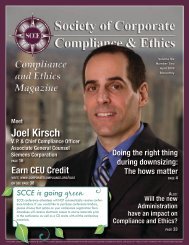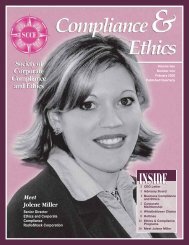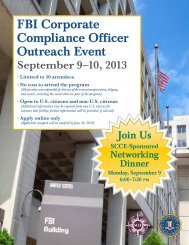Compliance &Ethics - Society of Corporate Compliance and Ethics
Compliance &Ethics - Society of Corporate Compliance and Ethics
Compliance &Ethics - Society of Corporate Compliance and Ethics
- No tags were found...
Create successful ePaper yourself
Turn your PDF publications into a flip-book with our unique Google optimized e-Paper software.
<strong>Compliance</strong> & <strong>Ethics</strong> Pr<strong>of</strong>essional May/June 2013<strong>and</strong> approves it, even though he should beusing one <strong>of</strong> three preferred vendors.The conflict <strong>of</strong> interest in this scenariolies with Harold, the purchasing manager.The company had three approved preferredvendors prior to Brian’s new vendor request.The company most likely was trying to keepthe number <strong>of</strong> vendors down so they coulddrive their purchasing volume to the preferredchoices <strong>and</strong> position themselves to negotiatelower prices for thefuture. The companymay also have had anannual volume rebatenegotiated with thepreferred vendorsthat could havereduced future paymentsto the vendors.All <strong>of</strong> the applicableincentives, discounts,<strong>and</strong> the preferred terms <strong>and</strong> conditionswould have been known to Harold; however,he chose to subordinate these benefits to thecompany so that he could serve the specificinterests <strong>of</strong> his cousin Brian in the Marketingdepartment.The existence <strong>of</strong> a potential conflict <strong>of</strong>interest in this scenario is not inherentlywrong. The real damage done to the organizationis the way in which the purchasingmanager reacted to or ignored the conflict. IfHarold had been provided documented guidanceon how to deal with pre-existing business<strong>and</strong> familial relationships that impact businesstransactions, his selection <strong>of</strong> a vendor wouldmost likely have produced a different result.Many people, left to their own devices in sucha situation, will seek to make a choice that createsthe least amount <strong>of</strong> personal conflict.One additional course <strong>of</strong> action for Haroldcould have been to simply disclose his familialrelationship to his supervisor <strong>and</strong> allowthat person to decide how to proceed with the“…instead <strong>of</strong> the disclosureserving as a warning,it can actually placea burden on those it wassupposed to protect.”processing <strong>of</strong> Brian’s purchase order. On thesurface, it seems reasonable <strong>and</strong> prudent toinvolve an objective decision-maker to absolveHarold <strong>of</strong> any potential conflict <strong>of</strong> interest.However, recent research on the disclosure <strong>of</strong>conflicts <strong>of</strong> interest would indicate otherwise.In a research paper, 1 the authors demonstratethrough various experiments that“…increased pressure results from advicerecipients feeling obliged to help satisfy theiradvisors’ personalinterests when thoseinterests have beendisclosed.” If we wereto apply the results <strong>of</strong>this research to ourscenario with Harold,his disclosure <strong>of</strong> aconflict to a supervisordoes not relievehim <strong>of</strong> the conflict butrather, “…instead <strong>of</strong> the disclosure serving asa warning, it can actually place a burden onthose it was supposed to protect.” The studygoes on to show that such a disclosure wouldmost likely cause the supervisor to haveincreased trust in Harold’s recommendation.So where can Harold go to gain relief fromhis conflict <strong>of</strong> interest? The prudent coursewould be to disclose the conflict <strong>and</strong> refrainfrom influencing the processing <strong>of</strong> his cousinBrian’s purchase order. This would ensure theintegrity <strong>of</strong> the purchasing process <strong>and</strong> set thest<strong>and</strong>ard for future interactions that present aconflict <strong>of</strong> interest.No harm, no foulAnd what <strong>of</strong> the application <strong>of</strong> my client’sclaim “no harm, no foul”? I would <strong>of</strong>fer thatthe harm could be defined as several addedcosts to the company for allowing the conflict<strong>of</strong> interest to remain, such as added processingtime to disclose the conflict <strong>and</strong> re-assign thetransaction to another purchasing manager,72 www.corporatecompliance.org +1 952 933 4977 or 888 277 4977




